One of the great things about screenprinting designs onto shirts is that pros can screenprint and so can home artists! But before you dive into this cool hobby, you need special supplies to screen print good-quality shirts. One of the most important supply decisions you have to make is to pick the best shirts for screen printing.
The best t-shirts for screen printing contain either 100% cotton or a blend of fibers with a high percentage of cotton. The softness and quality of the fabric can also impact the quality of the screen print. Other factors to consider include the type of tag in the shirt, the cut of the shirt, and the cost of the shirt.
In this article, you will learn how screen printing works and what kind of cloth it works best. You will find out the deciding factors for selecting the best t-shirts for this printing method. Finally, you will discover tips for selecting the best brand of shirts for your project.
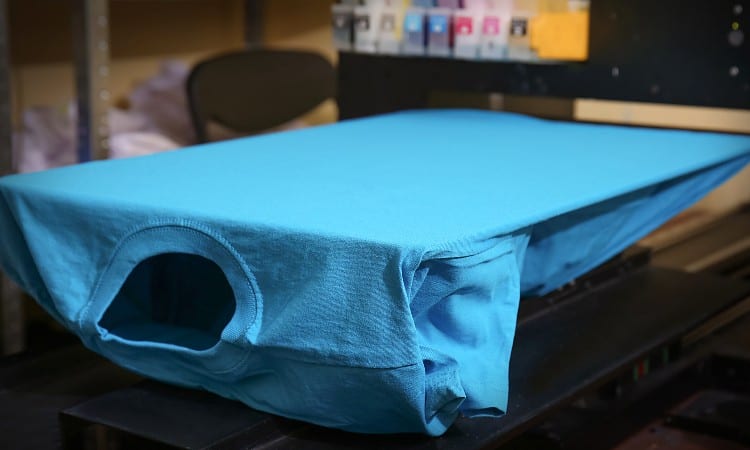
Quick Navigation
What is Screen Printing?
Screen printing is a textile art that uses ink pushed through a stenciled screen to create designs on fabric. This method of printing is one of the most popular ways to print high-quality tees. Both home artists and commercial t-shirt businesses use screen printing techniques.
Most modern screen printing uses thick plastisol ink that creates a raised design on the fabric’s surface. This design lasts a very long time without cracking or peeling and is one of the reasons screen print has such a high-quality feel and appearance.
For commercial printers, the screenprint process uses large machines and computerization. It begins with a digital design, often crafted using graphic design software. Screen prints typically work best with only a few colors, as each layer of ink needs its own stenciled screen.
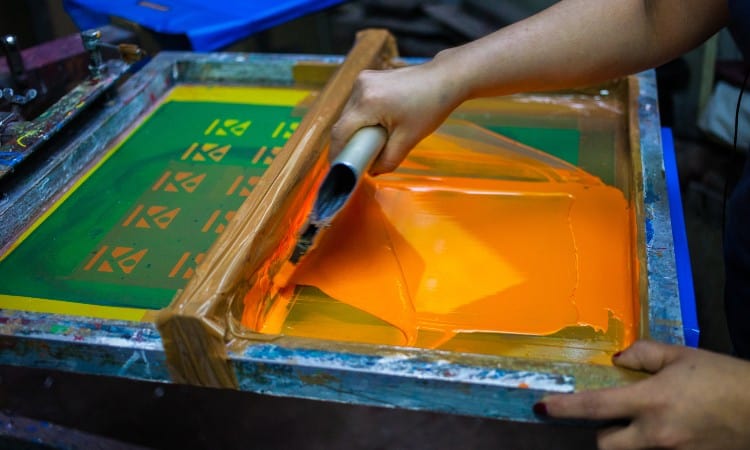
Next, the design prints out onto a clear sheet. This sheet, often made out of acetate, allows the printer to use an emulsion and exposure, much like the way old-fashioned photos used to be developed, to make the stencil. The printer starts by coating the mesh screen in a layer of a special emulsion.
Then the clear printed transfer lays on top of the emulsion. When the screen is exposed to intense light, the portions of the emulsion not under the printed design turn hard, while the parts under the design remain soft and will rinse away. This creates a negative space in the image or a perfect stencil!
This stencil then slots into a large, mechanized screen printer with arms for multiple screens and mechanized rubber squeegees to apply the ink. The ink goes onto the screen and the squeegee smooths it firmly over it. This pushes the ink through the stencil and onto the t-shirt!
Finally, the shirt goes through a heat-setting process to ensure that the thick, raised design stenciled onto the fabric will remain permanent.
If this sounds quite complex, keep in mind that you can also screen print at home with little more than a tube of ink, an old picture frame, and a piece of mesh. But at the professional level, the process has an automated component these days.
Can You Screen Print on Any Type of Shirt?
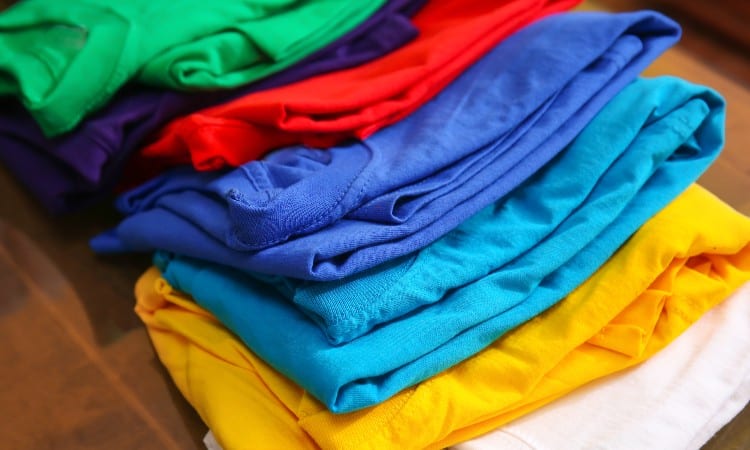
You can screen print on almost any material, but the best screen-printed shirts contain 100% cotton. You can also get excellent results using shirts with a high percentage of cotton but blending in other materials. Polycotton shirts with a 60-40 cotton to polyester blend can work, for example, and tri-blend shirts do well in screen printing so long as they contain a lot of cotton in the mix.
The reason cotton works better has to do with the way natural cotton fibers and synthetic polyester fibers react to water and plastisol inks. The bottom line is that cotton fabric can support complex screen print designs and can also withstand the high heat that makes these designs permanent. Screen print designs on polyester have a tendency toward an issue called dye migration.
While experts can screen print on polyester, these designs usually have a simple shape and may not remain nice for a long time. Screen printing onto synthetic fabrics also means that you have to use a different kind of ink and special additives to make this work. The regular screen printing process does not remain permanent on polyester as it does on cotton.
Technically, you can screen print onto almost anything, including glass, wood, ceramics, and paper! Every surface requires slight modifications to the printing process, though. Ultimately you have to decide what kind of shirt or product you want to offer your customers.
Best Quality T-Shirts for Screen Printing
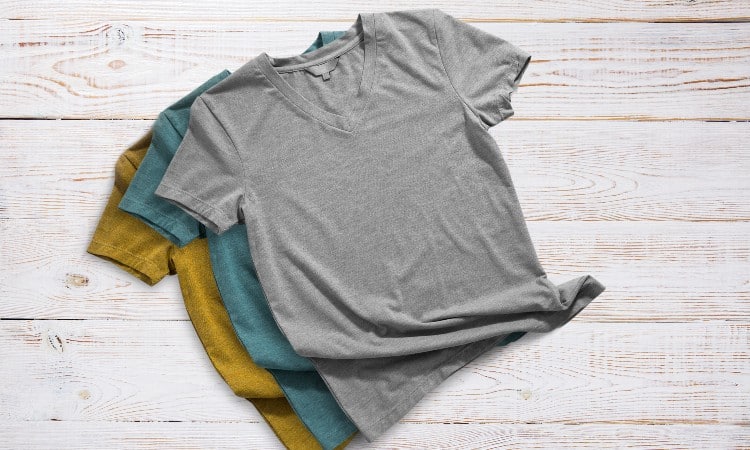
The best quality shirts for screen printing typically contain a large percentage of cotton, but you also have to consider other factors such as the cut of the shirt, the kind of tag it features, and even how much it will shrink over time!
Material
T-shirts containing either 100% cotton or a blend of fabric with a high percentage of cotton usually work best with screen-printed designs. That said, you do have to consider a few pros and cons when you select between cotton and polyester for your screen print project.
The main advantages of using polyester shirts are that polyester works best for athletic apparel because it offers moisture-wicking properties. It also costs much less than cotton, so you may prefer polyester shirts if you want a cheap bulk order. Polyester has excellent durability and does not stain or wrinkle easily, either.
On the other hand, screen prints on polyester often lead to dye migration, meaning that the plastisol ink used can blur or bleed. Plus, polyester has a high heat sensitivity and can scorch when the design goes through the heat-setting process.
Cotton holds screen print designs better than any other material. It can handle complex designs with multiple colors without any dye migration. It also provides excellent breathability and feels soft to the touch.
Of course, even cotton has a few potential downfalls! Cotton does not have the toughness of polyester and can wear out or get tiny bobbles on its surface. These bobbles can mess up the print. Plus, while this fabric feels much more breathable, it does not offer the moisture-wicking you need for intense athletic activities.
But overall, most experts agree that cotton offers the best, most reliable surface for screen printing. For this reason, you probably want to consider cotton tees for high-quality screen printing.
Softness
The softest t-shirts usually contain either 100% cotton or lightweight tri-blend material. The manufacturing process used to spin and weave the cotton can also impact the softness of the shirt.
One of the most important factors you have to consider when selecting a high-quality t-shirt is its softness. Customers do not want to pay for an expensive screen print design only to receive a coarse, uncomfortable garment to wear!
You may also want to consider the type of cotton used in the shirt. For instance, ringspun cotton goes through a more intricate manufacturing process, creating a softer fabric than regular cotton.
Shrinking
Cotton can shrink a lot when exposed to heat, and polyester does not easily shrink at all. This does give polyester one big advantage over cotton during the screen printing process, as your cotton tee could potentially shrink during the heat setting stage.
That said, you can order preshrunk cotton tees that will not undergo such an extreme shrinking process these days. This will help you avoid the issue almost entirely.
Cut
The cut or shape of a shirt will also impact how well it works for screen printing. Of course, you need to make sure you choose the correct style of shirt for your intended customers. If you want to sell sports jerseys, you may want to consider a raglan-sleeve style shirt, for example.
You also want to make sure the style of the shirt matches your screen print design. For example, if the shirt has a lapel pocket, you do not want part of the print to fall on top of the pocket! Alternatively, if you want to print a logo onto the upper left breast of the shirt, you may want a crewneck tee rather than a V-neck tee to print onto.
Seams
One of the lesser-known factors that can make a screen print shirt even better is the type of seams inside the garment. T-shirts usually either have side seams or have something called a tubular construction.
A tubular tee features a tube of fabric with holes cut out for sleeves and a neck stitched onto it. Tubular shirts cost less because manufacturers can make them more quickly. Unfortunately, a tubular style doesn’t usually fit well because most people do not have bodies shaped like cylinders!
A t-shirt with sideseams has seams sewn from the armpit to the hem of the shirt on each side. This shirt style has at least three separate pieces- the sleeves, front, and back- that get stitched together in a shape that fits the body much better.
Quality
The overall quality of a shirt also determines how well it works for screen printing. The quality of a t-shirt depends on several factors, including the type of fabric it contains, the weight of the fabric, and the thread count of the material.
Generally speaking, t-shirts made out of pure cotton have a higher quality than tees made of polyester or other synthetics. The only exception to this rule is high-performance sports tees–synthetic, moisture-wicking materials work better for athletic wear!
Besides the type of fabric used, the quality of a tee can depend on the weight of the material. The thicker fabric uses more fibers and tends to cost more. It will feel heavier in your hand and often has a softer touch.
T-shirts often come in a standard 5.5 oz weight, but you can find very light tees with a weight of 3.4 oz or heavier tees with a high-quality weight of 6.1 oz.
Finally, you can also look at the thread count in a t-shirt. Like in bed sheets, a higher thread count in shirts means more threads pack together into a square inch of the fabric. This typically indicates a softer, richer cotton fabric.
Type of Tag
It’s a small detail, but some of the best shirts for screen printing offer a tear-away tag rather than a sewn-in tag. Tear-away tags have a loose punched line that allows the tag to easily rip away without damaging the shirt.
You can also find tagless shirts with information stamped onto the fabric rather than printed onto a fabric tag. Many customers prefer this option as it avoids the issue of a scratchy or uncomfortable tag at the back of the neck.
Sellers of blanks often list this as a high-quality feature in the shirts they offer.
Cost
Of course, the cost plays a role in helping you pick the best t-shirts for screen printing! High cost may not always indicate high quality, but if you see a low price, you should look for cost-cutting features like a tubular shirt structure or sewn-in tags.
Blank t-shirts have an average cost of about $7, but you can often find them for $3 or less if you buy them in bulk. Of course, this can vary greatly from brand to brand, and some high-quality blank tees could easily cost over $10 each.
What T-Shirt Brand is the Best Quality?
A few of the best-quality t-shirt brands available now include Gildan, Bella Canvas, Jerzees, Hanes, and Fruit of the Loom.
Keep in mind that you want to check the fabric composition, the cut of the shirt, the seams, and the kind of tag as you select a good-quality t-shirt brand for screen printing.
This is not to say that other brands don’t offer high-quality blanks for screen printing, though! You can find hundreds of sellers online offering excellent deals when you buy blanks in bulk these days. Just make sure you do your research and investigate the quality of the search before you buy them and spend lots of time screen printing onto them!
Are Gildan shirts good quality? Like many well-known t-shirt brands, Gildan offers blank tees made of 100% cotton. You can find blanks in various styles, including a traditional crewneck with side seams.
What is the Best Shirt to Sublimate On?
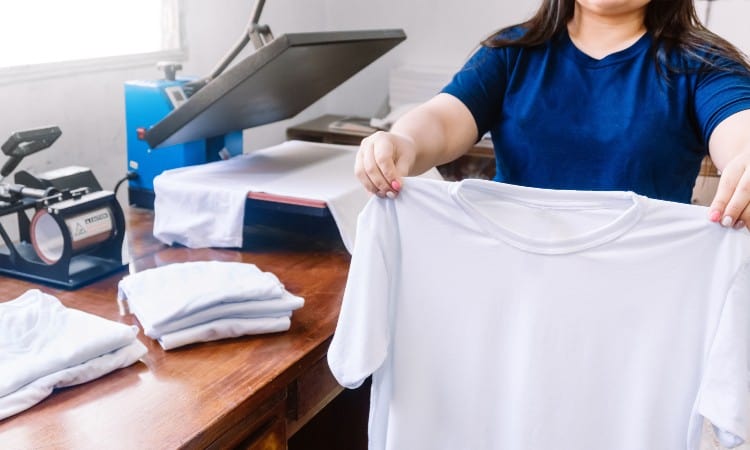
The best shirts to sublimate on must contain a high percentage of polyester because the sublimation printing process bonds ink with the polymers in this fabric. This type of printing does not work like screen printing at all. It uses a different kind of printer, different ink, and only works on polyester!
On top of this, your best bet with sublimation is to pick a white or light-colored shirt. Sublimating onto black or dark-colored tees does not work as well.
What exactly is sublimation? It is a newer method of textile printing that uses heat to turn a special type of dye into a gas. The gas then infiltrates polyester fabric, where the dye particles can bond with the polymers deep inside the cloth.
This process creates a detailed and highly durable print and has rapidly gained popularity because of its extreme effectiveness.
Best Shirts for DTG Printing
The best shirts for DTG or direct-to-garment printing contain either 100% cotton or at least a high percentage of cotton in the blend. Direct-to-garment printing uses special commercial printers to print a design straight onto the fabric, as the name suggests.
The water-soluble ink used does not play well with polyester. It works much better on an absorbent material like cotton. DTG printing also does not have the best reputation for super high-quality prints–screen printing or sublimation usually create richer, more durable designs.
High-Quality Blank T-Shirts for Printing
Finding high-quality blank t-shirts for printing may seem overwhelming with so many options on the market, so why not check out this handy guide to find the best shirts for women and men listed right here?
For Women
Brands like Bella Canvas and Hanes offer women a wide assortment of excellent blank shirts. One of the things you want to look for in a blank women’s shirt for screen printing is the cut of the tee. Most women’s tees have concave side seams to give the shirt more of a curved fit.
Bella Canvas Missy Jersey V-Neck
 This fitted V-neck misses tee contains 100% ring-spun cotton for a super soft shirt. Plus, the jersey-knit cotton comes in a durable 4.2 oz weight.
This fitted V-neck misses tee contains 100% ring-spun cotton for a super soft shirt. Plus, the jersey-knit cotton comes in a durable 4.2 oz weight.
You can select from twenty-nine different colors for this tee as well!
This shirt forms part of Bella Canvas’s relaxed collection that has a slightly looser fit, perfect for working from home or casual wear.
It has a V-neck and curved side seams.
Hanes Perfect T V-Neck
 Hanes offers a relaxed fit, slightly contoured women’s shirt with an elegant V-neck collar.
Hanes offers a relaxed fit, slightly contoured women’s shirt with an elegant V-neck collar.
You can buy this shirt in twelve different colors. It contains 100% ringspun cotton for a super soft and comfortable feel.
Hanes uses US-grown cotton for its blank tees. This particular Hanes option has a lightweight fabric and a very soft touch.
For Men
Gildan and Fruit of the Loom are two of the best brands offering blank men’s t-shirts for screen printing. Both brands feature several tee styles for men that contain 100% cotton and other high-quality features.
Gildan Men’s Heavy Cotton T-Shirt
 Gildan offers durable, soft, high-quality tees for men, especially if you pick their heavy cotton version like this one!
Gildan offers durable, soft, high-quality tees for men, especially if you pick their heavy cotton version like this one!
This shirt contains 100% cotton in a 5.3 oz weight. It comes in a 10-pack perfect or bulk printing orders.
This heavy-weight tee does have a tubular body instead of side seams. But it comes with a promised extra-smooth fabric surface perfect for screen printing!
Fruit of the Loom Boy’s Tag Free
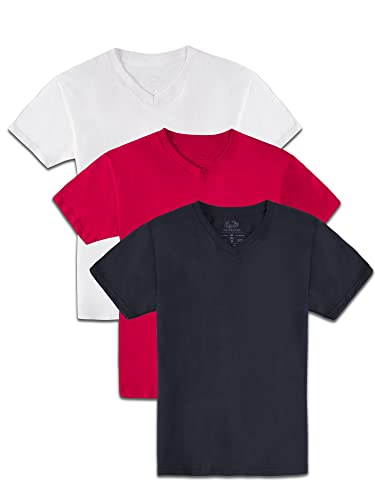 Fruit of the Loom sells a wide range of t-shirt styles for men and boys, as in this handy multi-pack of crewneck tees for boys.
Fruit of the Loom sells a wide range of t-shirt styles for men and boys, as in this handy multi-pack of crewneck tees for boys.
This shirt set features a blend of 60% cotton and 40% polyester suitable for the rough-and-tumble wear of young boys.
As a bonus, the shirts in this three-pack also feature a tag-free design to avoid chafing or irritation!
Cotton T-Shirts for Printing
Cotton t-shirts for printing come in all shapes and sizes, but a few brands like Gildan and Jerzees stand out from the crowd!
Jerzees Men’s Premium Ringspun
 If you want a quality midweight men’s tee made out of premium ringspun cotton, look no further!
If you want a quality midweight men’s tee made out of premium ringspun cotton, look no further!
This classic shirt with a regular cut and a ribbed crewneck collar comes in a 5.2 oz jersey knit fabric. You can select from 16 different solid colors, including mint and black.
This shirt also offers tear-away tags and shaped sleeves for a slightly more modern flair.
Hanes Ladies Ringspun Cotton Nano T
 It’s hard to go wrong with a Hanes tee as a blank for screen printing. This contoured, feminine cut features a V neck and fitted side seams.
It’s hard to go wrong with a Hanes tee as a blank for screen printing. This contoured, feminine cut features a V neck and fitted side seams.
It contains 100% ringspun cotton for extra softness and a smooth printing surface.
Besides offering a tag-free style, this t has a special mitered V neck for no awkward hemmed edges or chafing.
Conclusion
The best shirts for screen printing contain high-quality cotton that feels soft and provides a smooth surface for printed designs. Other key factors to consider in choosing a high-quality shirt include the cut of the shirt, the style of its seams, and whether it or not it features tags. You can also look at the thread count of the fabric or the weight of the fabric to help determine its quality.
Brands like Bella Canvas, Hanes, and Gildan all offer super popular blanks or shirts in solid colors perfect for printing. You can purchase these shirts alone or in bulk for your printing projects.